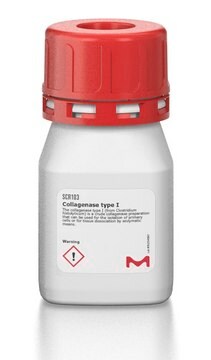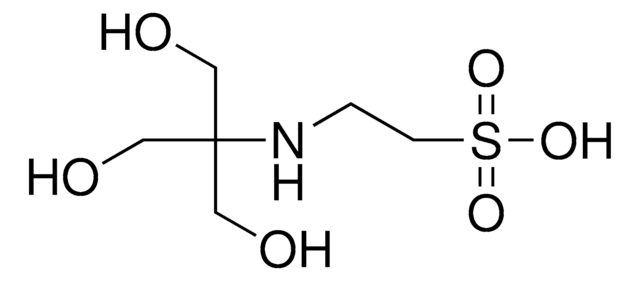C0773
Collagenase from Clostridium histolyticum
high purity, purified by chromatography, Type VII, ≥4 FALGPA units/mg solid, lyophilized powder, ≥700 CDU/mg solid (CDU = collagen digestion units)
Synonym(s):
Clostridiopeptidase A
About This Item
Recommended Products
Quality Level
type
Type VII
form
lyophilized powder
specific activity
≥4 FALGPA units/mg solid
≥700 CDU/mg solid (CDU = collagen digestion units)
mol wt
68-130 kDa
purified by
chromatography
composition
Protein, ≥85% biuret
solubility
TESCA buffer (50 mM TES, 0.36 mM Calcium chloride, pH 7.4): soluble 0.05-0.1 mg/mL at 37 °C
foreign activity
caseinase and clostripain ≤1 units/mg protein
storage temp.
−20°C
Looking for similar products? Visit Product Comparison Guide
Application
Biochem/physiol Actions
Unit Definition
Physical form
Preparation Note
substrate
signalword
Danger
hcodes
Hazard Classifications
Eye Irrit. 2 - Resp. Sens. 1 - Skin Irrit. 2 - STOT SE 3
target_organs
Respiratory system
Storage Class
11 - Combustible Solids
wgk_germany
WGK 1
flash_point_f
Not applicable
flash_point_c
Not applicable
ppe
dust mask type N95 (US), Eyeshields, Faceshields, Gloves
Certificates of Analysis (COA)
Search for Certificates of Analysis (COA) by entering the products Lot/Batch Number. Lot and Batch Numbers can be found on a product’s label following the words ‘Lot’ or ‘Batch’.
Already Own This Product?
Find documentation for the products that you have recently purchased in the Document Library.
Customers Also Viewed
Our team of scientists has experience in all areas of research including Life Science, Material Science, Chemical Synthesis, Chromatography, Analytical and many others.
Contact Technical Service






